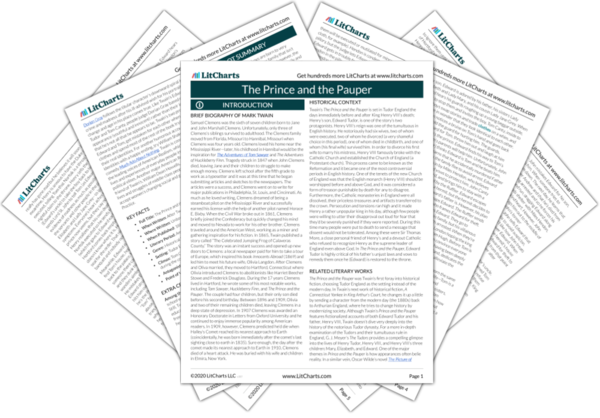Welcome to the LitCharts study guide on Mark Twain's The Prince and the Pauper. Created by the original team behind SparkNotes, LitCharts are the world's best literature guides.
The Prince and the Pauper: Introduction
The Prince and the Pauper: Plot Summary
The Prince and the Pauper: Detailed Summary & Analysis
The Prince and the Pauper: Themes
The Prince and the Pauper: Quotes
The Prince and the Pauper: Characters
The Prince and the Pauper: Symbols
The Prince and the Pauper: Literary Devices
The Prince and the Pauper: Theme Wheel
Brief Biography of Mark Twain

Historical Context of The Prince and the Pauper
Other Books Related to The Prince and the Pauper
- Full Title: The Prince and the Pauper
- When Written: After Twain’s 1867 European tour
- Where Written: United States
- When Published: 1881 in Canada, 1882 in the United States
- Literary Period: American Realism
- Genre: Historical Fiction; Satire; Children’s Literature
- Setting: Tudor England
- Climax: Tom Canty helps prove Edward Tudor’s true identity during the coronation ceremony in Westminster Abbey.
- Antagonist: John Canty
- Point of View: Third Person
Extra Credit for The Prince and the Pauper
Among the Stacks. Mark Twain dropped out of a traditional school when he was just 11 years old after finishing fifth grade. Still, Twain loved learning, so he spent as much time as he could educating himself in public libraries, where he enjoyed the freedom to follow his interests and learn more about them than he would have in a traditional school.
Namesake. Samuel Clemens famously loved steamboats and he spent a few years as a steamboat pilot on the Mississippi River. In fact, his love of steamboats and experience piloting them helped him decide on his most famous pen name, Mark Twain. Steamboats required that water be at least two fathoms deep to proceed safely, so on every steamboat there was a man who would use an instrument to determine the river’s depth. When it reached two meters, the man would call out, “by the mark twain!”







